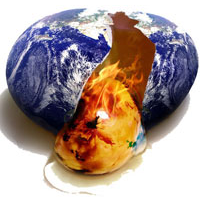U.S. Study Says Climate Change Could Kill What’s Left of S.F. Bay Marshes by 2100

Three weeks ago, dozens of people gathered in the city of Tiburton to celebrate the San Francisco Bay being named a “wetland of importance” by the U.S. government under an international treaty meant to help protect ecologically important waterways.
Last week, the U.S. Geological Survey (USGS) released a report that basically said the wetlands will be lucky to be around in the year 2100. “Future inhabitants of the Bay Area shoreline will see a very different set of wetlands and wildlife, according to our model,” USGS study author Karen Thorne said
Climate change is likely to turn much of the largest expanse of tidal salt marsh on the Pacific Coast of the United States into mudflats as higher global temperatures raise coastal waters precipitously, the report said. The USGS surveyed 12 marshes near Petaluma River, San Pablo Bay, Napa River and South San Francisco Bay and found that 95% will lose their vegetation under an all-too-likely scenario for a 4-foot sea-level rise.
“Losing marshes means losing the wild birds and animal species that depend on them, and we also lose the natural infrastructure that marshes serve as—as buffers against extreme tides and floods,” Thorne said.
The 12 sites represent about 12% of the Bay Area’s remaining marshes. The report tried to put a positive spin on the findings, suggesting that they might provide incentive for restoring more marshes and expanding their size before the rising sea moves in. But the cheery outlook relies on an “if / then” proposition that, at best, “might” retain the status quo.
“If there are other things we can do to help our existing marshes become more resilient to future changes and give migratory birds and endangered wildlife more habitat and time to adapt to sea level rise effects, then we might be able to keep pace with sea-level rise.”
The San Francisco Bay is both a bay and a 400,000-acre estuary that accounts for 77% of California’s remaining wetlands. It is a key habitat for 1,000 species of animals, including shorebirds on fly-by, and a broad range of flora and fauna.
It is an environment that has undergone dramatic changes in geography, hydrology and species during the past century. Between 80-90% of the low-salt areas of the estuary have been filled over the years to facilitate land use and development around the Bay Area.
Beth Huning, coordinator of the San Francisco Bay Joint Venture, reportedly told the Tiburton gathering, “The bay has experienced a number of challenges over the years, but the public will to protect this invaluable resource continues to grow,” she said.
The question remains: Is the tide of public opinion outpacing the encroaching Pacific ocean?
–Ken Broder
To Learn More:
San Francisco Bay Could Lose Marshes to Sea-Level Rise by 2100 (by Ben Young Landis, U.S. Geological Survey)
Modeling Sea-Level Rise in San Francisco Bay Estuary (U.S. Geological Survey)
Environmentalists, Officials Turn out in Tiburon to Cheer SF Bay Wetlands Designation (by Mark Prado, Marin Independent Journal)
- Top Stories
- Controversies
- Where is the Money Going?
- California and the Nation
- Appointments and Resignations
- Unusual News
- Latest News
- California Forbids U.S. Immigration Agents from Pretending to be Police
- California Lawmakers Urged to Strip “Self-Dealing” Tax Board of Its Duties
- Big Oil’s Grip on California
- Santa Cruz Police See Homeland Security Betrayal in Use of Gang Roundup as Cover for Immigration Raid
- Oil Companies Face Deadline to Stop Polluting California Groundwater





